| Description | Participants | Agenda (pdf) | Products |
|---|
Fast, Free Phylogenies: HPC for Phylogenetics Tutorial

Topic: High Performance Computing for Phylogenetics
Meeting dates: October 13-15, 2010
Location: NIMBioS at the University of Tennessee, Knoxville
Co-sponsors: NIMBioS, iPlant, and National Institute for Computational Sciences
Tutorial leaders: Eric Carr (NIMBioS); Jim Ferguson (NICS UTK/ORNL); Susan Holmes (Statistics, Stanford); Brian O’Meara (Ecology & Evolutionary Biology, UTK); Sheldon McKay (iPlant); Alexis Stamatakis (Computer & Communication Sciences, Tech. Univ. of Munich); Dan Stanzione (Adv. Computing Ctr/iPlant, Texas); Robert Thomson (Center for Population Biology, UC Davis); James Wilgenbusch (Scientific Computing, Florida State Univ.)
Objectives: This tutorial focused on how to use TeraGrid, the CIPRES Portal, the iPlant Discovery environment, university clusters, and other typically free HPC resources for phylogenetic analysis. The tutorial was geared primarily toward biologists (including students, postdocs and faculty) who were at least moderately experienced with phylogenetic analysis and who had datasets to run but were typically running analyses on their own desktops, though other researchers, such as statisticians or mathematicians working in phylogenetics, were encouraged to apply. Participants were encouraged to apply as teams (such as a pairing of a biologist and a statistician who collaborate in their work). Participants had the option of receiving instruction in basic Unix usage via webinar and self-paced online resources before the actual workshop, so lack of experience in this area was not a barrier to participation.
Products
Publications
Bonito G, Reynolds H, Robeson MS, Nelson J, Hodkinson BP, Tuskan G, Schadt CW, Vilgalys R. 2014. Plant host and soil origin influence fungal and bacterial assemblages in the roots of woody plants. Molecular Ecology, 23(13): 3356-3370. [Online]
Gong Z, Matzke NJ, Ermentrout B, Song D, Vendetti JE, Slatkin M, Oster G. 2012. Evolution of patterns on Conus shells. Proceedings of the National Academy of Sciences, 109(5): E234-E241. [Online]
Hodkinson BP, Lendemer JC. 2012. Phylogeny and taxonomy of an enigmatic sterile lichen. Systematic Botany, 37(4): 865-844. [Online]
Yang Y, Ricarda R, Morawetz JJ, Haevermans T, Aubriot X, Berry PE. 2012. Molecular phylogenetics and classification of Euphorbia subgenus Chamaesyce (Euphorbiaceae). Taxon, 61(4): 764-789(26). [Online]
Barnosky AD, Matzke N, Tomiya S, Wogan GOU, Swartz B, Quental TB, Marshall C, McGuire JL, Lindsey EL, Maguire KC, Mersey B, and Ferrer EA. 2011. Has the Earth's sixth mass extinction already arrived? Nature 471(7336): 51-57. [Online]
Cusimano N, Renner SS. 2010. Slowdowns in diversification rates from real phylogenies may not be real. Systematic Biology, 59(4): 458-464. [Online]
Sebastian P, Schaefer H, Telford IRH, Renner SS. 2010. Cucumber (Cucumis sativus) and melon (C. melo) have numerous wild relatives in Asia and Australia, and the sister species of melon is from Australia. Proceedings of the National Academy of Sciences, 107(32): 14269-14273. [Online]
Media Coverage
Drake N. 2011. Scientists try to determine whether life on Earth is quickly heading toward extinction. San Jose Mercury News. San Jose, CA. [Online]
Gibbons A. 2011. Are We in the Middle of a Sixth Mass Extinction? ScienceNOW [Online]
Karlamangla S. 2011. Mass Extinction May Occur in 300 Years, Scientists Say. The Daily Californian. Berkeley, CA. [Online]
NSF Press release. 2 March 2011. Earth's Sixth Mass Extinction: Is It Almost Here? [Online]
Pappas S. 2011. 6th mass extinction looms but preventable, study says. LiveScience, MSNBC. [Online]
Redell B. 2011. Interview of Nick Matzke. NBC Bay Area Morning Show. Bay Area: 2 hours.
Sanders R. 2011. "Has the Earth's sixth mass extinction already arrived?" Retrieved March 2, 2011. [Online]
Welch K. 2011. Interview of Nick Matzke. Saturday Morning Talkies, KPFA radio. Berkeley, CA: 1 hour. [Online]
Zimmer C. 2011. Outlook: Warm, Grim, Cloudy: My story on global warming and extinctions in tomorrow's NY Tiimes [sic]. The Loom. Retrieved 4/4/2011, 2011. [Online]
Zimmer C. 2011. Multitude of Species Face Climate Threat. New York Times. New York, New York Times: D1. [Online]
A goal of NIMBioS is to enhance the cadre of researchers capable of interdisciplinary efforts across mathematics and biology. As part of this goal, NIMBioS is committed to promoting diversity in all its activities. Diversity is considered in all its aspects, social and scientific, including gender, ethnicity, scientific field, career stage, geography and type of home institution. Questions regarding diversity issues should be directed to diversity@nimbios.org. You can read more about our Diversity Plan on our NIMBioS Policies web page. The NIMBioS building is fully handicapped accessible.
NIMBioS
1122 Volunteer Blvd., Suite 106
University of Tennessee
Knoxville,
TN 37996-3410
PH: (865) 974-9334
FAX: (865) 974-9461
Contact NIMBioS


